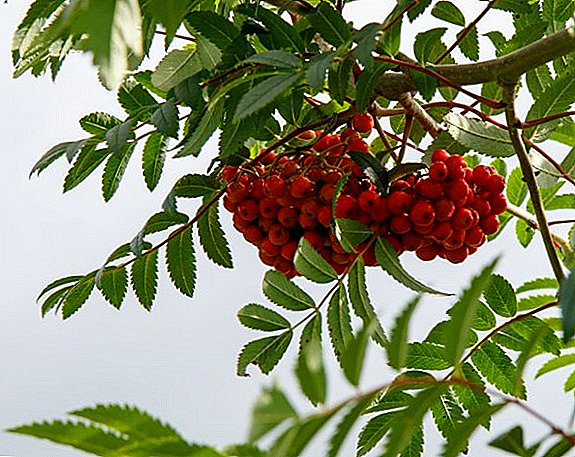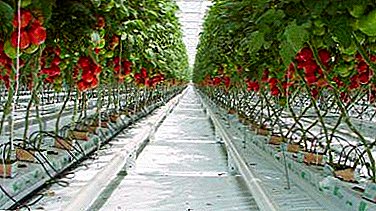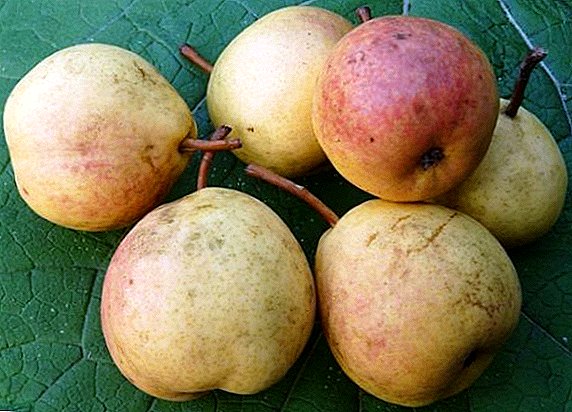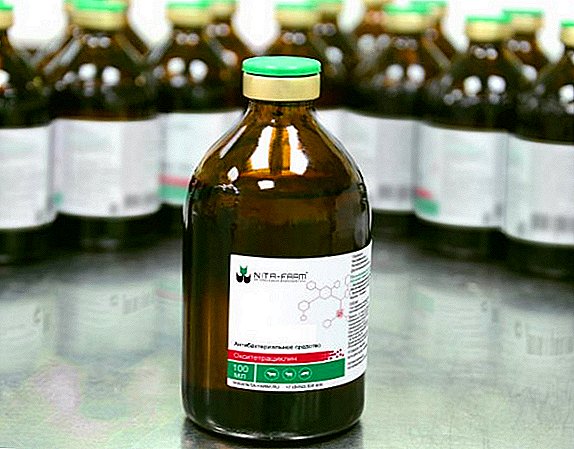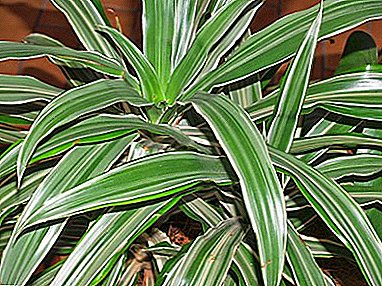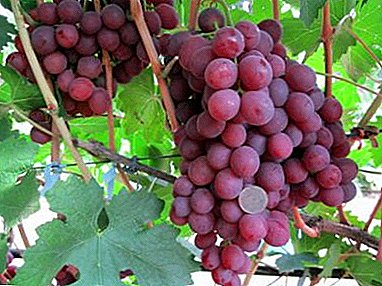
Nina grape variety - This is a hybrid form of amateur breeding grapes. The variety was bred not so long ago and has not yet managed to gain popularity and is completely in vain.
This grape is unpretentious and has many, noteworthy, unique properties.
In this article we will talk in detail about the grape variety Nina, tell you what features of its cultivation, what properties it has. You will also learn how much effort it requires for successful cultivation, what diseases and diseases it is subject to. And, of course, you will see it in the photo.
What kind is it?
Grape nina is red grapes. It refers to the early-medium or medium maturity, that is, from the bud break to the removable ripeness of the berries, 125-130 days pass.
At the same time, such famous and popular varieties as Strasensky, Augusta and Blagovest ripen.
How does it look like?
 This variety has great growth power, and when grown without a stock, on its own roots, can grow up to 3 m in height.
This variety has great growth power, and when grown without a stock, on its own roots, can grow up to 3 m in height.
Shoots ripen very well, clusters are large, cylindrical, fairly dense, can reach a mass of about 1 kg. On one shoot it is better to leave 1-2 clusters.
Bunches of Nina grapes are comparable in size to recognized leaders such as Rumba, Gourmet and Anyuta.
The berries are very large, dark red, almost burgundy in color with a slight violet shade, round, weighing about 10-12 grams.
The flesh is juicy and sweet, with a little sourness, meaty, very tasty. The skin is of medium density, but not eaten when eaten. Sometimes there may be a slight pea of berries.
This variety is bisexual, does not require fertilization near growing bushes. Need a normalization of the harvest. On one bush leave 30-40 shoots or 35-50 holes. One vineyard can be harvested 4-6 kg of berries per year.
 Grapes - not the only plant that is worth growing on your site. We bring to your attention a series of useful articles about gardening. Read about how to grow cherries, pears, plums, red and black currants.
Grapes - not the only plant that is worth growing on your site. We bring to your attention a series of useful articles about gardening. Read about how to grow cherries, pears, plums, red and black currants.A photo
In the photo you can see what this grape looks like.



Breeding history
The variety was bred by amateur breeder V.I. Krainov in 1996 in the city of Novocherkassk.
Obtained by crossing a very early Tomaisky grape variety with medium Radiant kishmish.
The most widespread Nina received throughout Ukraine and in southern Russia. The variety is not very well known, but it has already begun to be grown in the southern regions of Belarus and in some places in the Urals.
By the way, the hand of the same breeder belongs to all known varieties of Victor, Ruby Jubilee and Angelica.
Nina variety description
 Nina grapes can be attributed to the early or rather early medium varieties. Depending on the region of growth and soil composition, the ripening period can vary from 118 to 135 days.
Nina grapes can be attributed to the early or rather early medium varieties. Depending on the region of growth and soil composition, the ripening period can vary from 118 to 135 days.
With proper care, the variety is high yielding. and gives, on average, as already mentioned, 5 kg of berries from one bush.
The yield of this variety can be compared with the recognized leaders of Rkatsiteli, the Anniversary of the Kherson Summer Resident and the Memory of Dombkovska.
Nina grows well in light, loamy soils and prefers warm, well lit places, preferably at the wall of a house or other building. Best for Nina suitable fan, multi-arm shaping.
Nina grapes do not like thickening, excessive watering and excessive nitrogen supplements.
The general characteristics of the variety are shown in the table below.:
| Grade assignment: | dining room |
| Ripening: | early medium |
| Yield: | high |
| Bush growth: | vigorous |
| Frost resistance: | -22 |
| Color of berries: | Dark red |
| Taste: | harmonious |
| Bunch weight: | 500-700 g |
| Bunch density: | medium density |
| Berry weight: | 9-12 g |
| Berry shape: | rounded |
| Disease resistance: | to mildew about 3.5 points. Affected by oidium. |
 Forming planting in the garden, it is important to choose varieties of different plants so that they ripen for a long period and replace each other to please you as long as possible. We invite you to familiarize yourself with the varieties of cherries, apples, pears, plums, black and red currants.
Forming planting in the garden, it is important to choose varieties of different plants so that they ripen for a long period and replace each other to please you as long as possible. We invite you to familiarize yourself with the varieties of cherries, apples, pears, plums, black and red currants.Diseases and pests

Signs of oidium grapes
The risk of contracting mildew is smallbut it also cannot be ruled out. Sometimes this variety can get bacterial cancer and is very often attacked by pests.
The most dangerous and common pest is phylloxera.. Less commonly, Nina may be damaged by wasps and leafworms.
Oidium - A fungal disease affecting all parts of the plant. You can notice the manifestations of oidium by the appearance of an ash-like ash on the leaves. A little later shoots, buds and berries begin to be affected. Infected leaves and buds dry out and fall off, and the berries begin to crack, dry out and die off.
This disease appears with increased humidity, thickening of the bush and t + 22-25С.
As a preventive measure, it is necessary to ensure good ventilation of the vineyard and treat it with fungicides or sulfur solution at least three times per season.
Mildew the variety is rarely affected, but do not forget to sprinkle the bush with 1% Bordeaux mixture before and after flowering and at the beginning of the ripening of the berries.
Bacterial cancer occurs more often and manifests itself in the form of ugly growths on the shoots. It appears due to infection in the wound during pruning or inoculation.
All toolsused when weeding, cutting and loosening necessarily need to process a solution of manganese. It is better to avoid infection, because this disease is not treated and can lead to the death of the entire vineyard.

Signs of infection with grape phyloxera
When grown in a warm climate, the main "enemy" of grape Nina is a phylloxera.
More often you can meet the root and leaf forms of this pest.
The leaf phylloxera is clearly visible on the underside of the leaf, where it lays its eggs.
The defeat of the root phylloxera can be detected only by indirect signs: the withering away and drying of the shoots and leaves.
Drugs to combat the root phylloxera does not exist. Here will only help the complete destruction of all the affected bushes. When leaf phylloxera helps plant treatment with special fungicides.
To protect the grapes from wasps, you can use special traps and destroy wasp nests around the vineyard.
Cluster and grape leafworm also more common in areas with warm climates. Caterpillars of this pest cause considerable damage to the plant.
As a preventive measure, when removing the winter shelter, it is necessary to remove the old bark from the shoots. And before wrapping for the winter - remove all fallen leaves and pruning. If the pests do appear, only insecticide treatment will help.
 Not only grapes are prone to disease and pest attack. Other horticultural crops can also get sick, and diseases often overlap. It is useful to know what diseases of pears and apples exist and how to deal with them, and also what pests threaten fruit trees.
Not only grapes are prone to disease and pest attack. Other horticultural crops can also get sick, and diseases often overlap. It is useful to know what diseases of pears and apples exist and how to deal with them, and also what pests threaten fruit trees.findings
Nina grape variety unpretentious care, relatively winter-hardy and does not require special knowledge and experience of growing. It is suitable for landing at their summer cottage. If you do not miss the planned processing of the bush from oidium and pests, then this magnificent variety will regularly bring a consistently high yield of very tasty and beautiful berries.
Unpretentious varieties are also Muscat Delight, Zabava and Giovanni.
Watch a useful video about Nina grapes:


